A Paipo Interview with Bob Rose
December 25, 2010 - Bilambil, New South Wales (Australia)
Phone interview and questions by Bob Green
Photos courtesy of Bob Rose.
Originally from Sydney, for a time Bob shared a fibreglass bellyboard
with his brother-in-law. After riding standup for several years he
became fascinated with a friend's ply bellyboard. Since that time he
made and rode a ply bellyboard, and then a boogieboard, until health
and crowds made surfing difficult.
|
1. When and where did you
start surfing?
I was in Sydney originally, that's where I came
from. I
joined Coogee surf club in 1954. I was 17. I rowed in the junior boats
but I also surfed the old 16-footers which were made by Norm Casey, and
a few others down in Sydney. Then we went to the Olympic Games of
November 1956, and saw some of the most fantastic surfing on the old
mals at Torquay. It was just unbelievable. From that moment on we were
completely taken by it. When we got back to Sydney we really couldn't
wait to get our hands on them. I think myself and another guy, bought
the first two mals, ply mals, that Barry Bennett made. From then on we
went mad.
Bob on a 16-footer at Coogee.
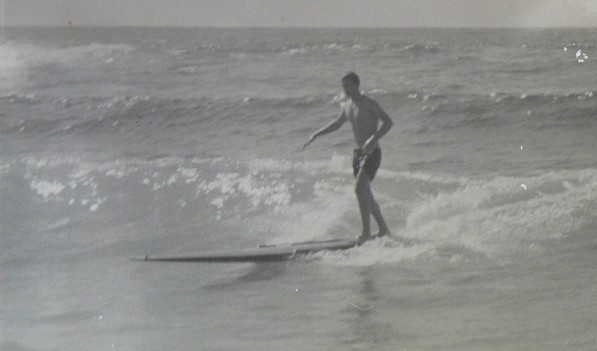
Photo courtesy Bob Rose.
Everybody in the surfing fraternity then knew each other, from Maroubra
to Bondi. We used to go over to the northside of Sydney quite a bit.
There were no jealousies or problems. We used to surf the Bower a bit,
right through to up north, anywhere there were waves. Most of the time
from 1956-57-58, it was very hard to buy cars, particularly as wages
weren't big. Once we could buy old cars, we'd wack the roof racks on
and that was when we started surfing all over the place. That lasted
for me for a long time, because I didn't do senior, I was in a trade. I
was mainly a Friday afternoon to Sunday afternoon, weekend surfer, as
everybody worked in those days. I surfed consistently until I got
married in 1963. I settled down but I still surfed, whenever I could,
mostly weekends or if I could get home early during the week.
Bob and Dianne Rose - Dee Why Point, c. 1961-1962.
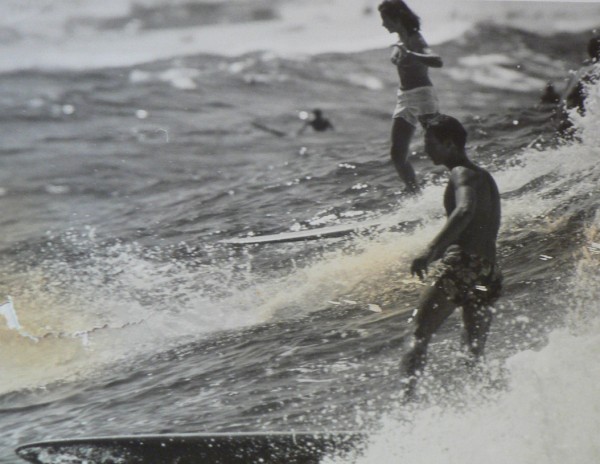
Photo Vic Joyce Studio,
courtesy Bob Rose.
2. Just to go back, with the 1956 Olympic team, did you
see any bellyboards?
No, we didn't.
There is a Cronulla photo where they have one in a
clubhouse room among the mals.
I've seen something like that. They did have one come to think of it.
It was made out of balsa. Of course there were no leg-ropes. It had a
ledge glued up at the front and they more or less hung onto that. They
had a couple of fins on them, the ones I can remember. But there
certainly weren't many at all.
3. What do you recall about the Greg McDonagh board that
you shared with your brother, it's design, and how it rode?
It was my brother-in-law, my wife's brother, Gordon Simpson. It was
his board. There was another guy who bought one, but he did very little
surfing. We used to borrow that off him occasionally. He had nothing to
do with surfing, he just bought one.
These boards were almost five foot long, these bellyboards. They really
went like a board but no-one thought about standing on them, not like
these days. These short boards they have these days are only about six
foot long, aren't they?
Did they have fins?
Yes, they had fins. They were set into the board like the old balsa
fins, as if they were part of the board. They were about 4" long and 3"
deep.
How did the board ride?
It was quite good. It was extremely fast because it was so big. I'd say
it was like lying on a small board. If you watch those guys on the
small boards they really fly. They really moved. But on a chop it was
really hard to keep down.
So it bumped a bit?
You're telling me. Really bumpy, you get the Morey now in a big chop,
it tends to glue itself, adhere itself to the face of the wall. But
these boards really buffeted and rocketed down. It wasn't a comfortable
ride.
Where did you surf them?
Mainly at Freshwater, Harbord. Mainly on the northside.
How long did you ride this board for?
1960, I think I rode it for about three years. My brother in law went
back to an ordinary board and I bought an old Midget Farrelly board
with a big broad single fin. I went back to boardriding again.
4. Did you see many other paipo riders around Sydney in
the 1960s? Where did you see paipo being ridden?
No, very few.
5. So when did you start on the ply paipo?
I more or less picked up the paipo board when Colin Taylor went down to
Melbourne and surfed with Kit Carson.
When was that?
Colin
went down to Melbourne to work about 1967. He, Kit Carson and
Jeff Callaghan would occasionally go down and surf Winkipop. A little
later, three or four years, I saw Col with these ply boards and
was fascinated by them. I sort of dropped the board and made my own
board from marine ply. There was nothing to it.
It was just a door handle on the front to put your hand through it, a
couple of glued in fins and that was it.
So you made your first ply board yourself?
Yes, they were so simple to make. You cut them out, sanded the edges,
and put a couple of very small fins on them which I fibreglassed onto
the ply. Surprisingly they stuck very well. And a door handle at the
front. I think they might have been about four foot long.
And guys in the surf told you were riding a door with
a handle?
Yeah that's right.
Bob's door with
a handle.
|
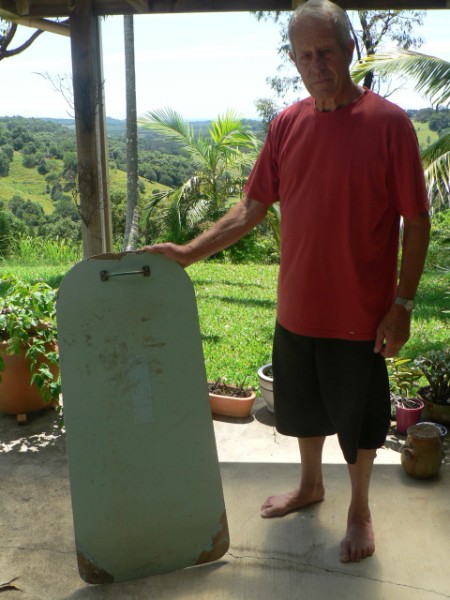
|
|
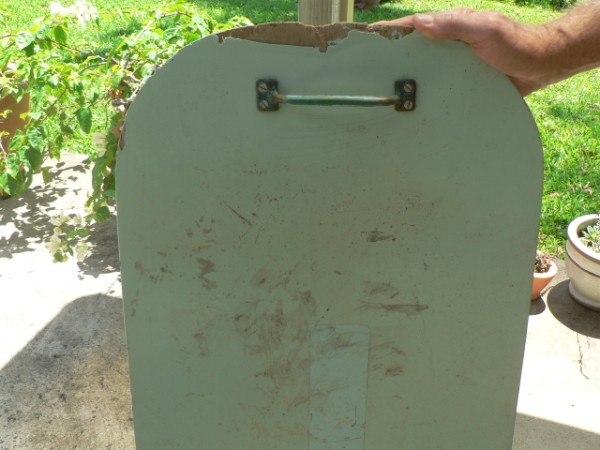
Board dimensions and features:
Length: 108 cm
(42.5")
Width (7.6 cm from the nose): 41 cm (16")
Width (7.6 cm from the tail): 51 cm (20")
Fins: 5 cm
(2") high and 9 cm (3.5") long.
The board is 3mm ply and when glassed 5mm.
|
Photo Bob Green.
Where was this?
Mainly when I came up here to live in 1980, off Snapper Rocks. It was
probably funny when you think about it. The beauty of that marine ply,
3-ply, was that it could bend slightly, you could lift the lip up, so
you wouldn't dig in and dive in down the face of the wave.
So you could get a bit of rocker in the board?
Could be that, you could bend it a bit. Colin gave me a lend of his and
of course I broke it in half. What happened was that I dug in and my
stomach stuck to the back of it and I snapped it in half. I made my
next one. I got it fibreglassed with a very thin sheet of glass and
that stopped the breakage. It gave it more resistance.
6. In 1980, there wouldn't have been too many guys on
bellyboards on the Gold Coast?
No, there weren't, next to nobody. except for Colin. Colin had come
back up from Melbourne to live in Coolangatta about 1971.
Was your board a copy of Colin's?
Basically, but I'm not sure if Colin's had fins. I put fins on mine and it
directed things a bit better. I don’t think Jeff Callaghan had
fins on his.
A smiple but functional design.
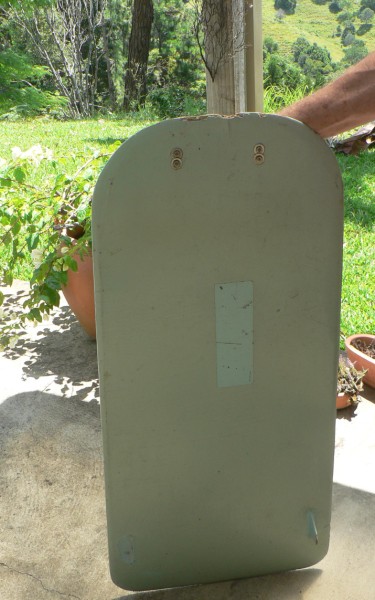
Photo Bob Green.
7. You mentioned when we first spoke, that around 1973,
you were
working contract work and didn't have much time to surf? What was the
attraction of a paipo board at this time?
That's right. Surf on the board, if you give it up, it's very hard
particularly as you get older. I could just grab the bellyboard, put a
pair of flippers on and go off Dee Why Point or wherever I wanted. It
was so easy. It was enjoyable.
You'd mentioned seeing bellyboard riders around Dee
Why Point in the 1960s?
Yeah. I remember one from Queenscliff going back a long, long time. He
was nicknamed the "The Rat." I can't remember his proper name. I didn't
know him.
Dee Why Point is a fairly serious wave - how did the
paipo go out there?
Very good. It was just a matter of waiting your time to get a wave. You
just couldn't pick any wave because of the amount of boards out there.
It was great, quite safe and easy to get out.
The board would hold an edge in the hollow waves?
Oh yes. It's amazing what you can do with a bellyboard. I thought they
were fantastic.
8. What was the attraction of bellyboards for you?
To
me, it was in my hand, I’m a reasonable swimmer. So it ducked down a
lot easier to get out than on a board. Cause these days, guys are so
fit with their duckdives, when they go under. They’re just amazing
these board riders now. But in my day, I would just dive well down
under the wave and come out the back, no problems. The other thing was
that the cord on the board wasn’t out. When the cords come in the
boards had it all over. If they were done, the wave would go over them
and they would paddle straight back out.
It took away that advantage.
It certainly did.
9. When did you stop regularly riding a bellyboard?
In 1998, I had my first hip transplant in my right hip. I still rode after
it, in fact, I'd still be riding now but it's so bloody awkward off
Snapper Rocks. It's just no-go, especially since they put in that sand
pipe. At one stage there was only one place you could get the wave and
there would be 120 guys sitting out there. I gave it away then.
Do you still go out in the water?
Yes, if I can pick a spot by myself. Kirra is interesting, nobody much
surfs Kirra these days. I just go out for a small enjoyable wave or up
toward North Kirra.
10. You also mentioned riding a boogie board for a
while. How does a paipo compare with a boogie board?
One good thing about the boogie board is that
it is a
comfortable ride. You can't get hurt with it. The ply board can give
you a nasty bruise, if you dig in or if it comes down, you roll with
the wave and the edge of it catches you on the side of the head or the
body. But with the boogie board I found it was a very safe ride. It
didn't matter how hard the wave hit, you weren't going to get hurt. The
bellyboard tends to feel itself a little bit more. It's slower and it
can be very fast too if you want to get out of it. My bellyboard was
like a shot out of a gun once it started. A little bit uncontrollable
because of the speed. I enjoyed the boogie board in a wave up to 5-6
feet. Once it got bigger I wanted something fast and that was the paipo
board. It was faster for me, but I thoroughly enjoyed the boogie board
too.
I made a board for Colin after I broke my board. I still have mine
here. It's only got one fin on it at the moment, but you can still ride
it.
The one-finned
bellyboard.
|
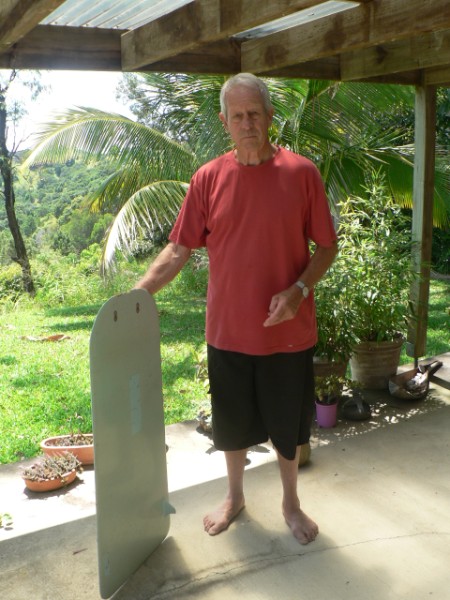
|
|
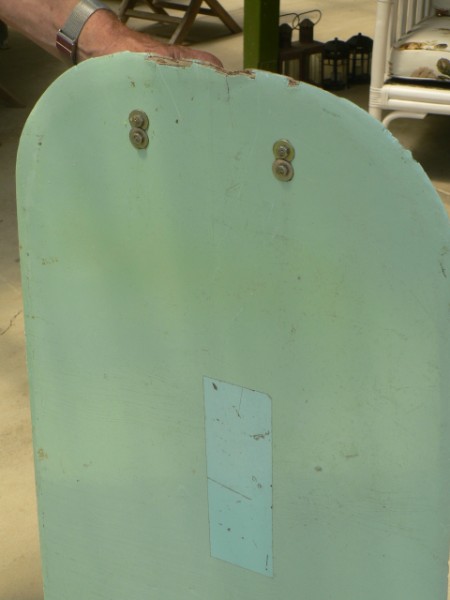
|
Photo Bob Green.
11. Besides Col who else do you know who has ridden
bellyboard?
Just a small group, very, very few. The other day I've seen one other
guy come out of the surf. His was fairly long, it almost looked like a
surfboard. It was about 6 to 8 foot' and looked like an ironing board.
Possibly a wooden alaia.
It could have been. It was only about 15 inches wide.
Back in the 1960s did you mainly surf with Col?
Yes, then in the 1960s, he came back up to Coolangatta. He's been up here
ever since with the exception of a stint in Melbourne. He used to ride
the boards up here, but when he went to Melbourne to work Kit was
doing paipo down there so he went with Kit riding paipo.
12. Any waves still stand out for you?
I never really judged the surfs by the years or days. I'd just go out
and enjoy the surf.
So there is nowhere that you remember as the best
waves that you had?
Dee Why Point and North Narrabeen when it's on. North Narrabeen would
get packed even in the 1960s. Snapper Rocks is a beautiful wave. You'd
get some big surf off Snapper occasionally, but never the size of the
surf off Dee Why. Bigger waves at Dee Why and they hit a lot harder
too. I always felt quite safe out there because you could dive a fair
depth and just go under the waves.
13. The other thing I was interested in was that your
brother-in-law, Gordon Simpson, rode a belly board? You mentioned that
Gordon went to Hawaii in 1961, and featured in the Bruce Brown film, Surfing Hollow Days. What do you know about this trip and Gordon's
ride at Waimea in this film?
He went with Bob Evans and a consignment of other surfers - Bobby Pyke,
Micky McMann. He thoroughly enjoyed himself. Gordon always liked a big
wave. We went to the movies one day and they said Gordon Simpson is on
there. He went across this wave on a paipo board. It was a big Waimea
wave.
Bob Pyke with Bob Rose on the inside
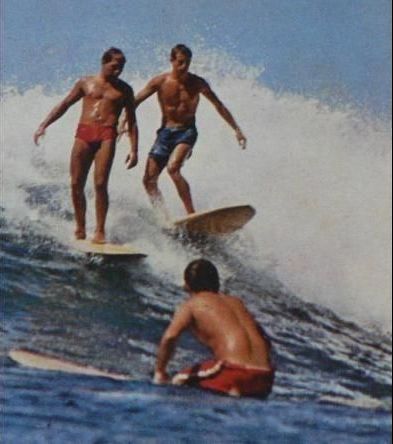
Photo courtesy Bob Rose.
It's not something he talked about much?
No, never. Close friends. He was part of the old fraternity, just enjoy
the surf.
How long did he surf a bellyboard for?
It wasn't that long. He just went back to a standup board. Up to 2 to 3 years ago
he was surfing on a boogie board. But now he has a very bad shoulder
and I don't think he surfs much at all. He's 70 now.
14. Any other comments?
The only thing I get a bit shitty about is the
Morey Boogie
boards. I don't know how they keep surfing. I know they get a good deal
at Duranbah. Duranbah is full of boogie board riders, but at Snapper
Rocks, if your body is in the water on a boogie board or paipo board,
life is pretty hard. Some guys are pretty decent who won't worry. But
the worst part with the paipo or boogie is that if you are on the
inside you can come out fairly quick, the smart ones will hover behind
you and cut behind you, and when you look back they reckon it's their
wave but you know they have come from further back out and cut back on
top of you. That's the only thing that spoiled it a little bit for me.
When we first went out there everyone knew each other but after a while
it just built up and you lost touch.
Did you surf anywhere else much on a bellyboard?
I surfed in Victoria at Point Roadknight, near Anglesea and down the
south coast a little bit but was mainly a Sydney guy. I surfed mainly
between Maroubra and Palm Beach with stints, to Coolangatta when we
came here on holidays.
Gordon Simpson (at rear), Malcolm Saunders and Bob Rose
(right). Fairy Bower.
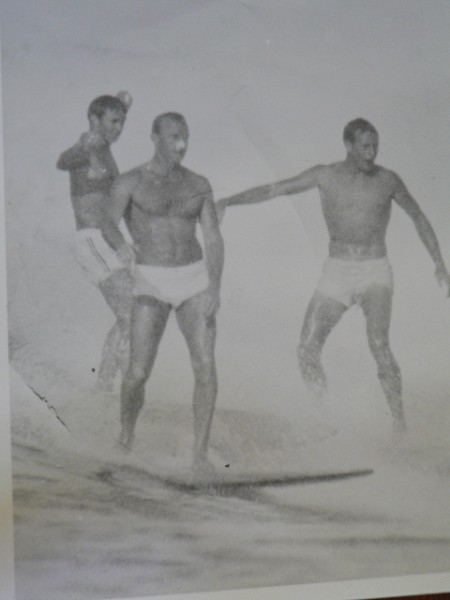
Photo courtesy Bob Rose.
|
|








